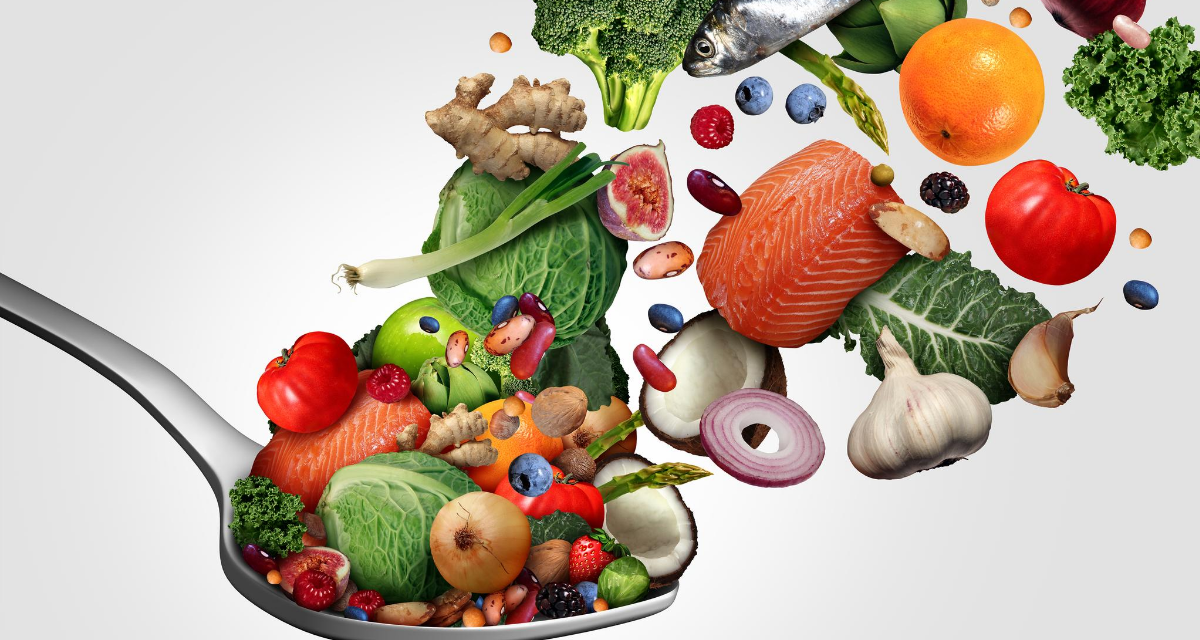The most significant way you affect your health, weight, mind, emotions, and spirit is with the food you eat. How you choose to nourish yourself plays a role in your character, relationships, and accomplishments, and profoundly affects your life. Your reason for choosing food is a fundamental and personal issue.
Are your choices made unconsciously and habitually? Or influenced by clever advertising, or because a friend, relative, or celebrity told you it was good for you? A lot of people continue to eat what’s familiar, convenient, or what they were raised on. Others choose based on flavors and textures, while emotional reaction is the driving force for many food choices.
Popular trends that come and go and often contradict each other are frequently the standard for what we eat. These are just a few of the thousands of reasons humans choose their nourishment. They do not necessarily produce health and happiness.
Educated, conscious and pro-active choosing will help you create the healthy, fit body that you desire, and save you a great deal of time, energy, and money on visits to the doctor, medical procedures, and medications. This article provides a greater understanding of how food really works in your body.
Esther suffered for years with the pain of fibromyalgia and IBS. She got pain relief from monthly steroid shots that were greatly compromising her bone health and not really healing the condition. The pharmaceuticals for her digestive system were causing new symptoms. By cultural standards her diet was not bad; however, her food choices were 95% of the cause of her poor health. Can you imagine how pleased she was to be able to eliminate steroids and drugs by eating the therapeutic foods I suggested? She eliminated the pain and healed her digestion.
All food can be used as medicine when you understand its unique properties and how to use it for your personal condition. You can reverse disease, maintain healthy weight and peaceful, harmonious emotions—even handle stress better—with knowledge of nutritional therapy. This post focuses on some foods, mostly vegetables, to help reverse health imbalances.
Vegetables provide the full spectrum of vitamins and minerals you need to live and grow healthfully, and there’s far more value to them than nutrients as described in those featured below. Eat a minimum of four cups of a variety daily prepared in different ways—steaming, boiling, roasting, sautéing, blanching, raw, homemade pickling, and grilling. Each method of cooking produces a different effect on your health and will be discussed in a future issue. Some common and uncommon vegetables are described below.
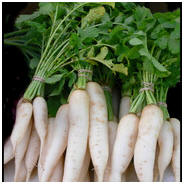
Daikon is a white radish with a pungent flavor and cooling nature. It acts as a solvent breaking down and eliminating stored fats especially in the digestive tract and liver. It is a very useful food for lung congestion and mucus. Daikon clears liver stagnation and cools an overheated liver that can cause high blood pressure, headaches, insomnia, menopause problems, impatience, irritability, and anger. It is a great detoxifier. It is effective against many bacterial and fungal infections and is useful for treating candidiasis and many liver diseases. Digestive enzymes diastase, esterase, and amylase are found in daikon. Because of its ability to break down fats, it is an effective weight loss aid.
Uses: slice and add to soups or stir fries; steam and drizzle with fresh lemon or vinegar; roast; pickle; or grate raw on salads. I do not peel daikon; it’s best to eat the whole food. Scrub it with a vegetable brush. If you buy it with the leaves still attached, wash and steam them.

Cabbage is slightly warming, sweet and pungent, and mucilaginous. It moistens intestines; benefits stomach; and improves digestion. It is useful for treating constipation, the common cold, whooping cough, irritability and depression. Cabbage helps rid the digestive systems of worms, and can help heal ulcers because of its high vitamin U content. Eating it regularly helps overcome chronic cold feet. It is used in many cultures to beautify the skin.
Cabbage contains important antioxidants vitamins A and C (more vitamin C than oranges); is a rich source of B vitamins and K1; iodine, and anti-inflammatory compounds. The outer leaves are concentrated in vitamin E and contain at least a third more calcium than the inner leaves.
Cabbage owes many of its healing properties to its abundant sulfur content. Sulfur, a vital mineral found in all body tissues, destroys parasites; purifies the blood; helps resist bacteria; and protects against toxic substances.
Uses: Cole slaw, sauerkraut and other pickling methods; sautéed; add to soups. Try my Colorful Cabbage Slaw or Regeneration Soup.

Turmeric contains anti-inflammatory and antioxidant properties. It protects the liver and promotes healthy blood; reduces arthritis symptoms, boosts immunity, and lessens insulin resistance. Turmeric has beneficial effects for allergies, asthma, atherosclerosis, heart disease, Alzheimer’s disease, diabetes and cancer. It supports healthy joints, maintains normal cholesterol levels, improves digestion and is said to slow down aging.
Uses: Regularly add organic turmeric powder to vegetables, soups, or grains; or stir into heated water and drink as a tea. If taking it as a supplement please buy organic. Zesty Split Pea Soup with Turmeric

Apple cider vinegar is a great tonic to detoxify the whole body. I prefer the unfiltered, organic variety. It contains enzymes, potassium, calcium, and other essential minerals.
Apple cider vinegar helps your body maintain a healthy alkaline PH level; counters fatigue; reduces effects of allergies; helps eradicate yeast, fungi and thrush. It is a powerful remedy for quickly clearing stagnant liver energy and the accompanying depression. Vinegar contains the sour and bitter flavors and its thermal nature is warming. Distilled vinegar is highly de-mineralizing and should be avoided.
Uses: Add one teaspoon to a cup of heated water and drink several times daily. You can add a little raw, unprocessed honey to improve its effects. Please don’t drink it undiluted or you’ll create problems with your esophagus over time. You can also use in salad dressings and drizzled over vegetables.
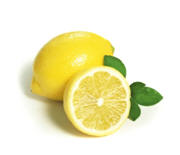
The sour flavor is most active in the liver where it counteracts the effects of rich, greasy food, and the heavier foods of winter. It functions as a solvent by breaking down fats and protein. Lemon helps in the digestion and assimilation of minerals, and can strengthen weak lungs. In spring it’s health-supportive to emphasize sour foods such as lemon, sauerkraut, vinegar, pickles, berries, rhubarb, and tart green apples.
Lemon – The sour flavor is most active in the liver where it counteracts the effects of rich, greasy food, and the heavier foods of winter. It functions as a solvent by breaking down fats and protein. Lemon helps in the digestion and assimilation of minerals, and can strengthen weak lungs. In spring it’s health-supportive to emphasize sour foods such as lemon, sauerkraut, vinegar, pickles, berries, rhubarb, and tart green apples.
Uses: Start your day with a cup of warm water with 1-2 teaspoons of fresh lemon. Squeeze fresh lemon over vegetables, fish, and other foods. Or try my vegan gluten-free Lemon Pie.
Naturally Fermented Vegetables – Traditional cultures have used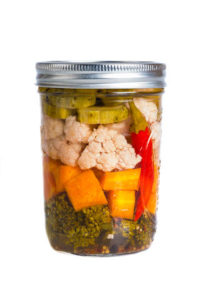 fermented foods for thousands of years as a digestive aid. Homemade pickles contain beneficial enzymes and bacteria that aid digestion and overall health. Your digestive system is responsible for about 80% of your health. The fermentation process changes the sweetness of the vegetables into a useful enzyme that strengthens the stomach and intestines. They also help reduce cravings, especially for sweets.
fermented foods for thousands of years as a digestive aid. Homemade pickles contain beneficial enzymes and bacteria that aid digestion and overall health. Your digestive system is responsible for about 80% of your health. The fermentation process changes the sweetness of the vegetables into a useful enzyme that strengthens the stomach and intestines. They also help reduce cravings, especially for sweets.
When foods containing beneficial bacteria are eaten consistently over time, digestive issues, bloating, and belly fat will greatly decrease. Supermarket pickles are quickly processed and will not have the same benefits. Purchase from a reputable health food store and avoid those that contain sugar. Fermented Vegetable recipes. Good quality sauerkraut and miso are good sources for healthy bacteria.
Uses: Eat a few pieces once daily with a meal.
 Kale is warming, sweet, slightly bitter/pungent; eases lung congestion; benefits the stomach; treats stomach and duodenal ulcers. All hard, dark leafy greens benefit the heart; help reduce blood pressure; have anti-inflammatory properties; reduce damp conditions such as candida yeast, fungi and parasites; reduce moist accumulations including edema; and support mental focus and alertness.
Kale is warming, sweet, slightly bitter/pungent; eases lung congestion; benefits the stomach; treats stomach and duodenal ulcers. All hard, dark leafy greens benefit the heart; help reduce blood pressure; have anti-inflammatory properties; reduce damp conditions such as candida yeast, fungi and parasites; reduce moist accumulations including edema; and support mental focus and alertness.
This ancient member of the cabbage family has abundant sulfur; and is a good source of chlorophyll, calcium, iron, and vitamin A.
Uses: Steam, sauté, and add to soups. Recipes here
Seaweed – Your body began its development in a saline solution in the womb and is nourished and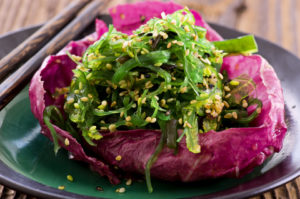 cleansed by blood that has almost the same composition as sea water. Blood contains a hundred or more minerals and trace elements found in the ocean. Seaweeds contain the greatest amount and broadest range of minerals of any organism in a form that is highly assimilated. Because of the high mineral content they are effective when eaten regularly in relatively small amounts.
cleansed by blood that has almost the same composition as sea water. Blood contains a hundred or more minerals and trace elements found in the ocean. Seaweeds contain the greatest amount and broadest range of minerals of any organism in a form that is highly assimilated. Because of the high mineral content they are effective when eaten regularly in relatively small amounts.
Seaweed detoxifies including mercury and heavy metals; transforms phlegm; removes residues of radiation; acts as lymphatic and blood cleansers; alkalizes the blood; alleviates liver stagnation; benefits the liver, lungs, digestion, kidneys and bones. You’ll benefit more by eating it as food rather taking as a supplement. The most common varieties are nori, kombu, wakame, arame, hijiki, dulse, and agar.
Uses: Use kombu in beans to eliminate digestive gas. Use wakame in soups, and agar for jelled desserts. Hijiki and Arame can be cooked with vegetables. Rinse dulse and add to salads or any vegetable dish. Seaweed Recipes Here
Consciously examining your choices and why you make them opens the door to better health. Your mind influences the effects of any choice even when you aren’t aware of your thoughts. Pay attention!
Get to know and understand food beyond nutritional measures and make new food choices based on a holistic rather than reductionist perspective. Start with some of the foods in this article.
I can help you master the art of wisely choosing foods that will support your healthy, fit body and mind, and nourish your life. Consider scheduling a session or taking new actions from Best Practices for a Healthy Mind and Body.
Never underestimate the power of food to heal. Exercise your power by choosing foods intentionally. You’ll be more grounded and have the stamina and well being that will free you to live the healthy, happy, abundant life you were meant to live.
My upcoming Be Your Own Weight Loss Guru Webinar provides comprehensive information on food therapeutics and much more. Even if you’re not trying to lose weight, you’ll benefit from this true Holistic approach to health and nutrition. Subscribe to newsletter to be notified of date.
There are many popular food plans and no lack of internet advice from thousands of people who lack an understanding of food therapeutics and have little or no professional training. Good marketing sells fads to people who are desperately trying to recover good health and lose weight. Current scientific findings often contradict previous findings by the same experts. A perfect diet that will bring everyone good health does not exist and accepting this fact is a good starting point for achieving balanced health.
Consider some professional guidance in crafting the right nutrition plan for you. Schedule a Holistic Health and Nutrition session with Deborah Barr, who has decades of professional training and clinical experience. You’ll be on your way to better health. Sessions can be done by phone, Skype, Zoom, facetime, or at my Pittsburgh office.
All articles and information on this website are protected under copyright laws and are owned by Deborah Barr, Whole Health Resources. You may use this article in your print or electronic publication at no charge. I ask that you contact me letting me know in what publication you will use my article and when it will be published. You are required to use bio and copyright information at end of each article and mail a copy of the publication or link to online publication to me once published.
If you are in need of additional articles or fresh article ideas, contact me. I will be happy to discuss some relevant article topics.

